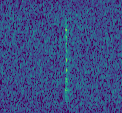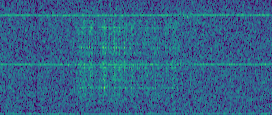In one of my latest posts I analysed the meteor scatter pings from GRAVES on a recording I did on August 11 (see that post for more details about the recording). The recording covered the frequency range from 142.5MHz to 146.5MHz and was 1 hour and 34 minutes long. Here I look at the Amateur stations that can be heard in the recording. Note that Amateur activity in meteor scatter communications increases considerably during large meteor showers, due to the higher probabilities of making contacts.
In my reporting I have spotted a total of four DX (distant) stations doing digital meteor scatter. All of them are using the old FSK441 mode instead of the newer MSK144. This is somehow a pity. MSK144 performs much better than FSK441, so it should completely replace it. In fact, the authors of WSJT-X have not implemented FSK441 in WSJT-X, as it is rather pointless. The old WSJT (now completely superseeded by WSJT-X) has to be used for FSK441.
I hear that in the USA MSK144 has become really popular, wiping out all FSK441 use. However, it seems that in Europe FSK441 is still the most popular mode for 2m meteor scatter by far. I wonder what can be done to increase MSK144 activity.
The timestamps I will give for the signals shown here are realtive, referring to the beginning of the recording (which was 08:56 UTC). The resolution of the waterfalls is 22Hz or 45ms per pixel.
At 00:01:05 we have a short 100ms ping from C37MS, a Belgian team that does meteor scatter from Andorra.

At 00:28:25 we have F6KBF, a radio club near Paris, France.

At 01:08:00 we have a weak ping. I was only able to decode the locator JN05, which is in the Limousin region, France.

At 01:24:50 we have DF2ZC, a station in South West Germany.

Besides these DX stations, in the recording there are a lot of FSK441 transmissions by EA4SG, who lives in Colmenar Viejo, a few kilometres away from my location. Therefore, his signal is pretty strong.
An interesting find was the following CW transmission at 01:26:15. It reads “S50C S50C NNT KKK”. I don’t know whether S50C, a radioclub station in Slovenia, was the transmitter or the receiver of that message. The resolution for the image below is 47Hz or 21ms per pixel.

The recordings for the signals shown in this post, as well as the scripts to produce the waterfall images can be downloaded here.
Hi Daniel ,
we are many to agree on this MSK144 is NOT better than FSK441 because it is unable to decode short reflections .
I hope it will never replace FSK441 because it means less dx qso
73
Dom
Hi Dom,
Thanks for replying to this old post. That’s quite interesting feedback about the difference between FSK441 and MSK144. However, I partially disagree with your comment.
According to the documentation, an MSK144 frame takes 72ms to transmit, regardless of the information sent. FSK441 messages are a different, because they are character based, so they don’t have fixed length. However, a typical exchange such as “W9XYZ K1ABC 27” given in the user guide has around 14 characters. This takes 95ms to transmit.
So actually MSK144 is somewhat faster to send the message than FSK441. However (and here probably comes the important part), an MSK144 message is either decoded correctly or not at all. In contrast, each of the characters of FSK441 might be decoded correctly, or as garbage. With a ping shorter than 95ms you’ll get some correct characters and the rest will be garbage. Then it is the operator who mentally puts in the missing information according to context.
Since MSK144 has FEC, it is not true that it needs a ping of at least 72ms to work. It can work with pings somewhat shorter than this, but not very short. With FSK144 you can get a few characters from a very short ping, since each character takes 2.3ms to send.
So I think this what makes it possible to do FSK441 QSOs with pings where MSK144 would fail. By the way MSK144 has also shorthand messages, which send hashes instead of the full callsigns and take only 20ms to send. Maybe people aren’t taking enough advantage of shorthand messages.
Now we get into difficult terrain with the topic about what’s the minimal information you need to exchange. In my opinion this is a bit of a boring non-technical discussion.
A purist might argue that you need to copy both callsigns completely with the signal report exchange. A more practical approach would be that it’s enough if you’ve copied both callsigns completely at least once in the previous messages. Of course you know your callsign, and also the DX’s if you’re doing a sked, but typically logging a QSO without being able to copy the callsigns over the air is considered cheating.
MSK144 makes it easier in this respect, since the computer does all the decoding for you and you don’t need to use your imagination to fill in the missing characters. For the same reason I would accept the criticism that using MSK144 is more boring.
The Souris Valley ARC in North Central North Dakota (DN98IB) will do our best to help hams put ND in their 6m logs during the peak of the Persieds meteor shower by putting K0AJW on 6m from our sunset on August 12 (02:46 UTC) until sunrise on August 13th (10:52 UTC). We will be calling CQ using MSK144 AND MSK145. If anyone wants to try a schedule during that period (or before) contact me at ferrara@srt.com and we’ll try to accommodate you.